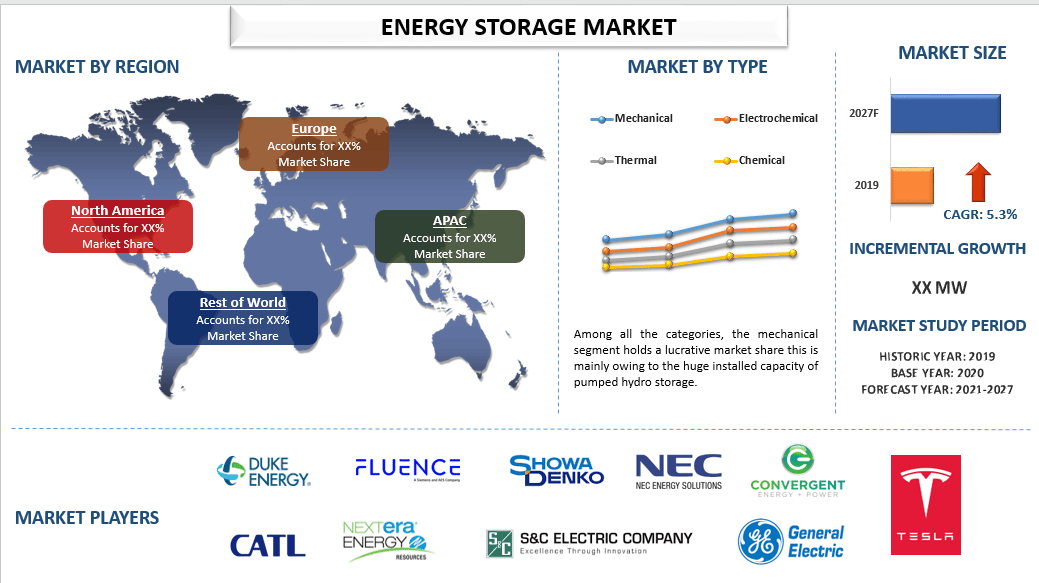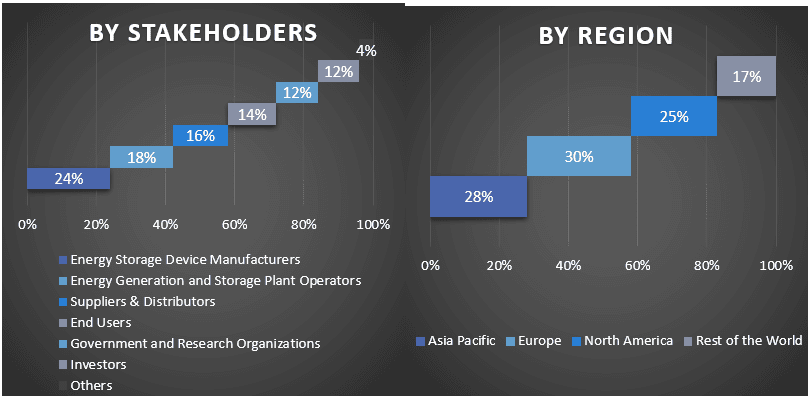- Home
- About Us
- Industry
- Services
- Reading
- Contact Us
Energy Storage Market: Current Analysis and Forecast (2021-2027)
Emphasis on Type [Mechanical (Pumped Hydro Storage, Liquid Air Energy Storage, Compressed Air Storage, Other); Electrochemical (Lithium Battery, Lead-Acid Battery, Sodium-Sulfur Battery, Others), Thermal, Chemical]; Region/Country

The Global Energy Storage Market size was 191,111.4 MW in 2020 and is expected to grow at a CAGR of 5.3% during the forecast period. The demand for energy storage systems is driven by the increasing need to reduce the dependence on oil, gas, and coal for electricity generation in order to reduce carbon emissions. In 2019, transportation and electricity generation were responsible for nearly 54% of greenhouse gas emissions in the US. As a result, nations across the globe are shifting towards renewable energy sources. However, fluctuating power requirements during different times of the day are propelling the demand for energy storage systems from renewable energy power plants. These energy storage devices store the generated energy from power plants during low energy demand and supply the energy during peak hours.
Contemporary Amperex Technology Co. Limited, Convergent Energy and Power LP, Duke Energy Corporation, Fluence Energy Inc., General Electric Company, Showa Denko, NextEra Energy Inc., NEC Energy Solutions Inc., S&C Electric Company, and Tesla Inc. are some of the key players in the market. Several M&As along with partnerships have been undertaken by these players to facilitate customers with hi-tech and innovative products/technologies.
Insights Presented in the Report
“Amongst type, the mechanical segment holds a prominent share of the energy storage market”
On the basis of type, the energy storage market is divided into mechanical, electrochemical, thermal, and chemical storage systems. Among all, mechanical storage methods hold a lucrative market share this is due to the presence of a considerable number of pumped hydro storage systems using water reservoirs. Further, compressed air energy storage is also a type of mechanical storage system and accounts for a considerable market share for energy storage systems. It stores compressed air when surplus energy is produced from wind turbines and there is less energy consumption. Compressed air energy storage involves converting electrical energy into high-pressure compressed air that can be released at a later time to drive a turbine generator to produce electricity.
“North America held a noteworthy share of the global energy storage market”
North America grabbed a significant market share as the economy, health, and safety of citizens along with national security of it depend on the reliable delivery of electricity. The region has witnessed the acceleration in the deployment of technologies that help in improving the reliability and efficiency of utility operations, including the deployment of systems and practices to better engage utility customers in the management of energy. Therefore, there has been a rise in smart grid deployment and investment in countries including the U.S., Canada, etc. For instance, the investment in smart grids rose by 41% between 2014 and 2016 from $3.4 billion to $4.8 billion annually. This investment is expected to rise to $13.8 billion by 2024. Furthermore, the high degree of renewable penetration in the region, the need for reliable and uninterrupted power supply, and the aging grid infrastructure are some of the other prominent factors contributing to the high demand for energy storage systems in the region.
Reasons to buy this report:
- The study includes market sizing and forecasting analysis validated by authenticated key industry experts.
- The report presents a quick review of overall industry performance at one glance.
- The report covers an in-depth analysis of prominent industry peers with a primary focus on key business financials, product portfolio, expansion strategies, and recent developments.
- Detailed examination of drivers, restraints, key trends, and opportunities prevailing in the industry.
- The study comprehensively covers the market across different segments.
- Deep dive regional level analysis of the industry.
Customization Options:
Global energy storage market can further be customized as per the requirement or any other market segment. Besides this, UMI understands that you may have your own business needs, hence feel free to connect with us to get a report that completely suits your requirements.
Table of Content
Analyzing the historical market, estimation of the current market, and forecasting the future market of the global energy storage market were the three major steps undertaken to create and analyze the adoption of energy storage in major regions globally. Exhaustive secondary research was conducted to collect the historical market numbers and estimate the current market size. Secondly, to validate these insights, numerous findings and assumptions were taken into consideration. Moreover, exhaustive primary interviews were also conducted, with industry experts across the value chain of the global energy storage market. Post assumption and validation of market numbers through primary interviews, we employed a top-down/bottom-up approach to forecasting the complete market size. Thereafter, market breakdown and data triangulation methods were adopted to estimate and analyze the market size of segments and sub-segments of the industry pertains to. Detailed methodology is explained below:
Analysis of Historical Market Size
Step 1: In-Depth Study of Secondary Sources:
Detail secondary study was conducted to obtain the historical market size of the energy storage market through company internal sources such as annual report & financial statements, performance presentations, press releases, etc., and external sources including journals, news & articles, government publications, competitor publications, sector reports, third-party database, and other credible publications.
Step 2: Market Segmentation:
After obtaining the historical market size of the energy storage market, we conducted a detailed secondary analysis to gather historical market insights and share for different segments & sub-segments for major regions. Major segments included in the report as the type. Further country-level analyses were conducted to evaluate the overall adoption of testing models in that region.
Step 3: Factor Analysis:
After acquiring the historical market size of different segments and sub-segments, we conducted a detailed factor analysis to estimate the current market size of the energy storage market. Further, we conducted factor analysis using dependent and independent variables such as various types of energy storage. A thorough analysis was conducted for demand and supply-side scenarios considering top partnerships, mergers and acquisitions, business expansion, and product launches in the energy storage market sector across the globe.
Current Market Size Estimate & Forecast
Current Market Sizing: Based on actionable insights from the above 3 steps, we arrived at the current market size, key players in the global energy storage market, and market shares of the segments. All the required percentage shares split, and market breakdowns were determined using the above-mentioned secondary approach and were verified through primary interviews.
Estimation & Forecasting: For market estimation and forecast, weights were assigned to different factors including drivers & trends, restraints, and opportunities available for the stakeholders. After analyzing these factors, relevant forecasting techniques i.e., top-down/bottom-up approach was applied to arrive at the market forecast about 2027 for different segments and sub-segments across the major markets globally. The research methodology adopted to estimate the market size encompasses:
- The industry’s market size, in terms of volume (MW) and the adoption rate of the energy storage market across the major markets domestically
- All percentage shares, splits, and breakdowns of market segments and sub-segments
- Key players in the global energy storage market in terms of solutions offered. Also, the growth strategies adopted by these players to compete in the fast-growing market
Market Size and Share Validation
Primary Research: In-depth interviews were conducted with the Key Opinion Leaders (KOLs) including Top Level Executives (CXO/VPs, Sales Head, Marketing Head, Operational Head, and Regional Head, Country Head, etc.) across major regions. Primary research findings were then summarized, and statistical analysis was performed to prove the stated hypothesis. Inputs from primary research were consolidated with secondary findings, hence turning information into actionable insights.
Split of Primary Participants in Different Regions

Market Engineering
Data triangulation technique was employed to complete the overall market estimation and to arrive at precise statistical numbers for each segment and sub-segment of the global energy storage market. Data was split into several segments & sub-segments post studying various parameters and trends in the areas of the type in the global energy storage market.
The main objective of the Global Energy Storage Market Study
The current & future market trends of the global energy storage market were pinpointed in the study. Investors can gain strategic insights to base their discretion for investments from the qualitative and quantitative analysis performed in the study. Current and future market trends were determined the overall attractiveness of the market at a regional level, providing a platform for the industrial participant to exploit the untapped market to benefit as a first-mover advantage. Other quantitative goals of the studies include:
- Analyze the current and forecast market size of the energy storage market in terms of volume (MW). Also, analyze the current and forecast market size of different segments and sub-segments
- Segments in the study include areas of
- Define and analysis of the regulatory framework for the energy storage market industry
- Analyze the value chain involved with the presence of various intermediaries, along with analyzing customer and competitor behaviors of the industry
- Analyze the current and forecast market size of the energy storage market for the major region
- Major countries of regions studied in the report include Asia Pacific, Europe, North America, and Rest of the World
- Company profiles of the energy storage market and the growth strategies adopted by the market players to sustain in the fast-growing market
- Deep dive regional level analysis of the industry
Related Reports
Customers who bought this item also bought










